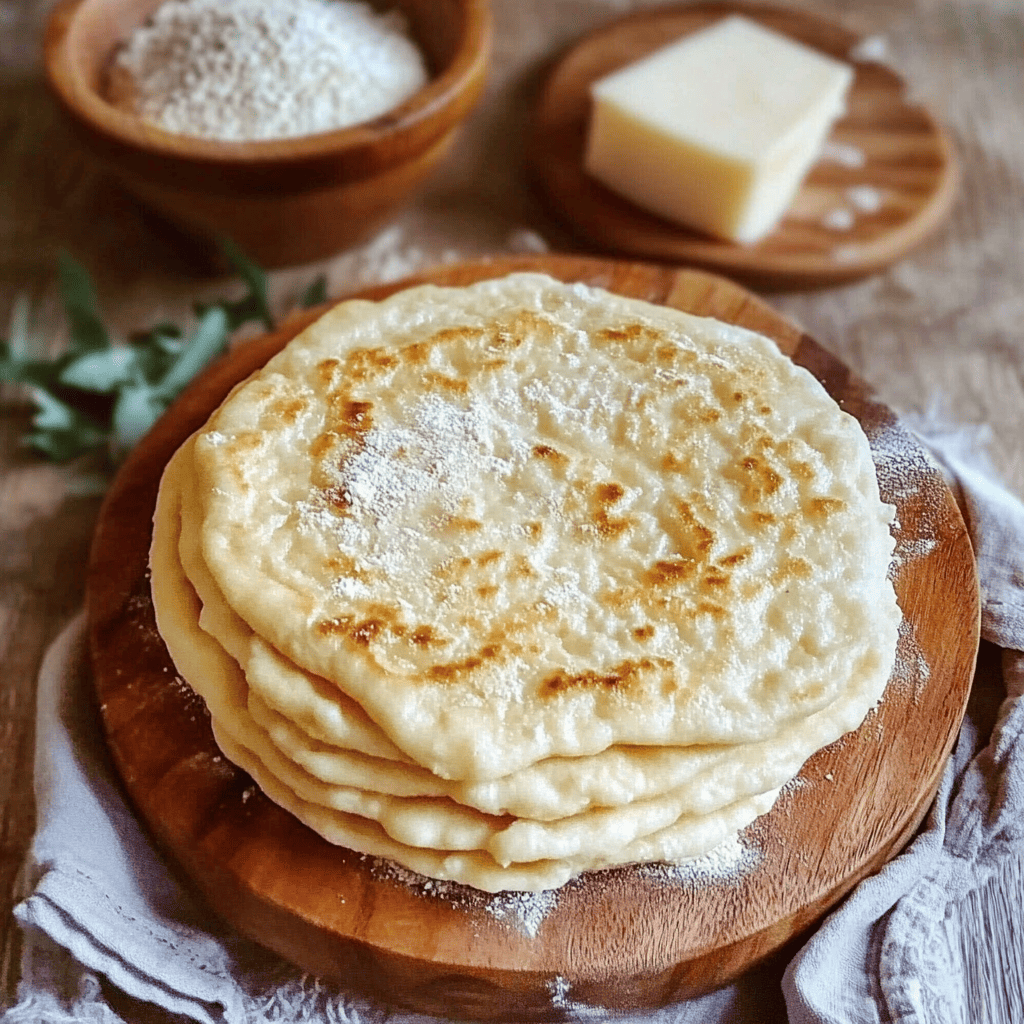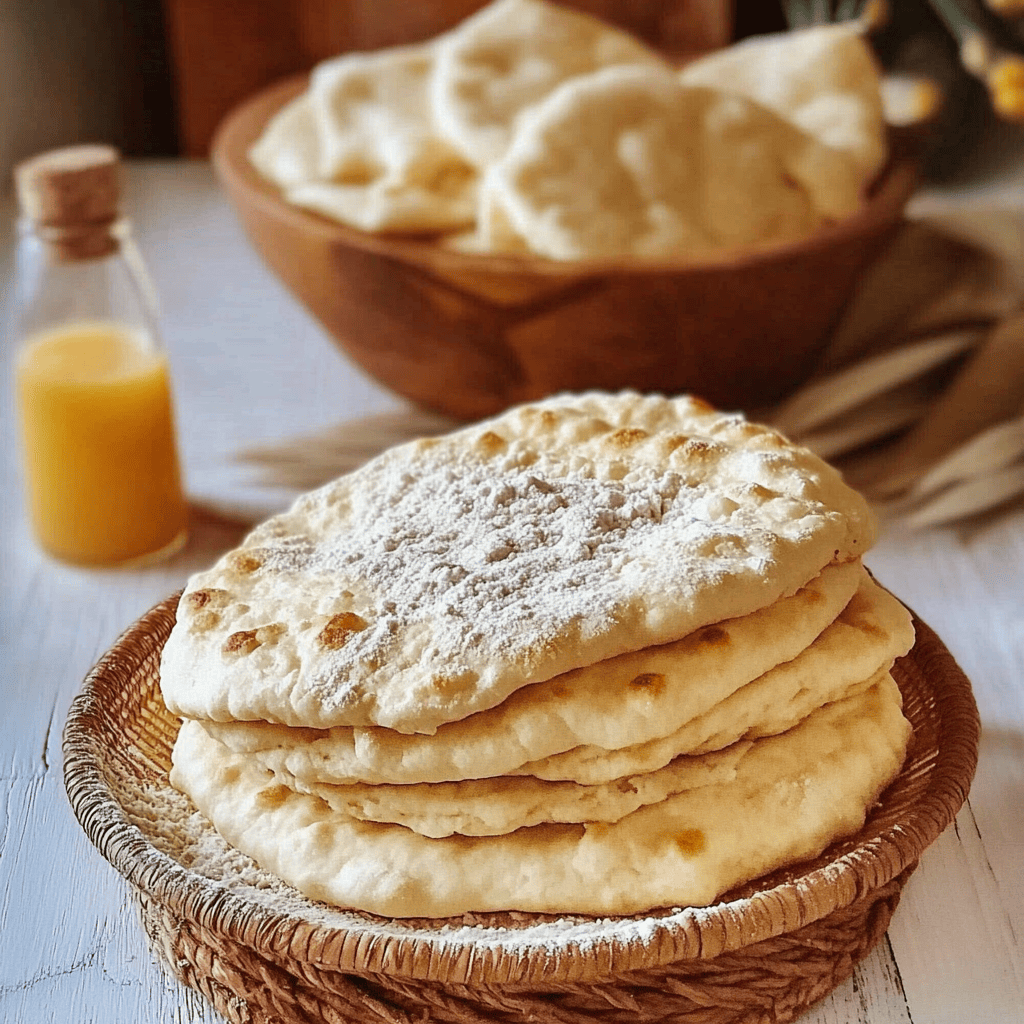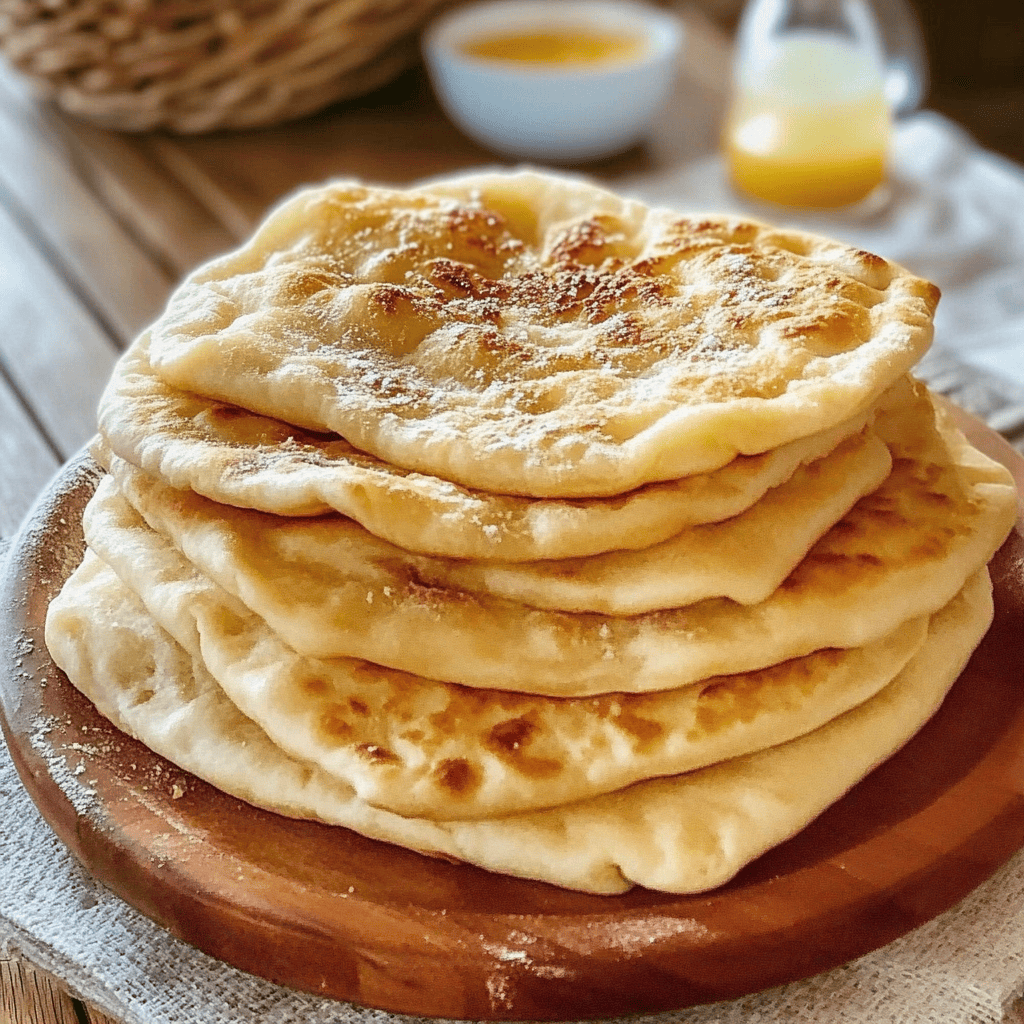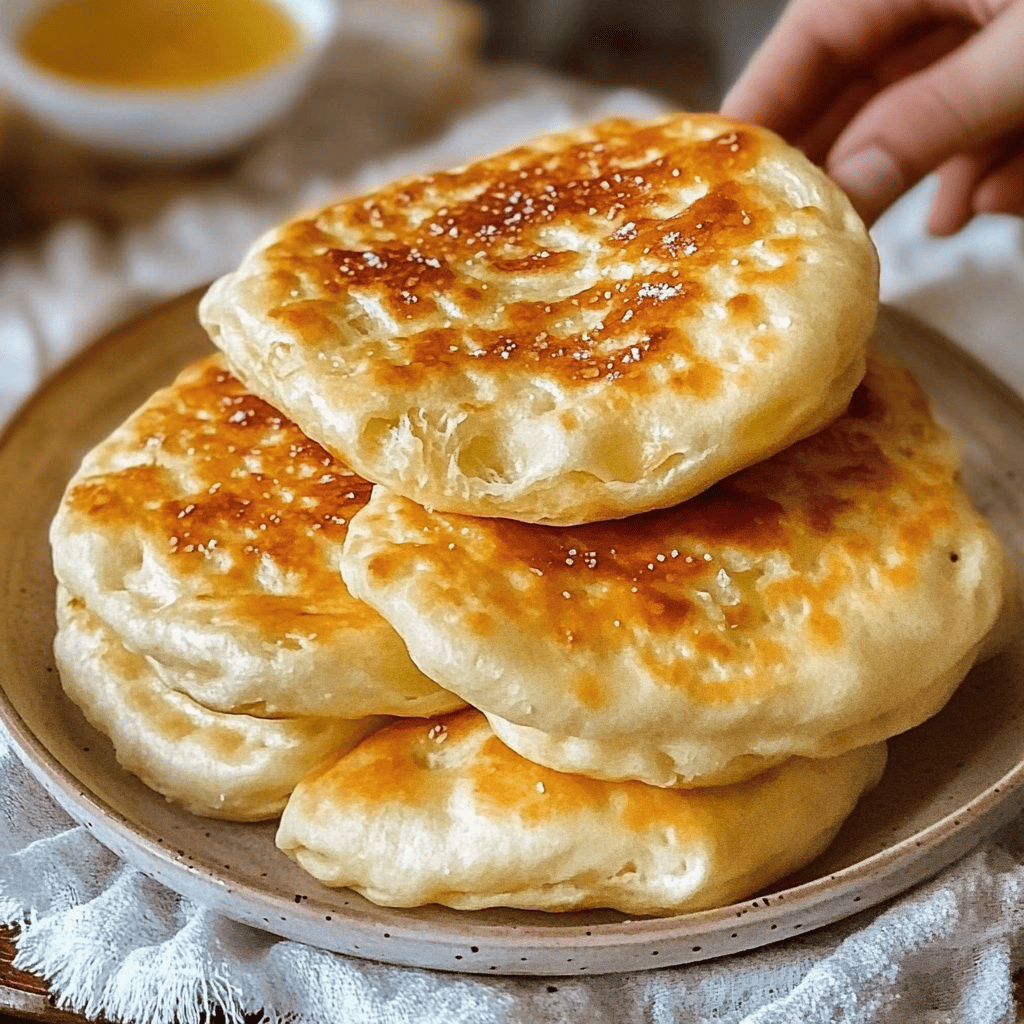Turkish Bread (Bazlama): The Pleasure of a Fluffy and Versatile Flatbread
Introduction: A Comforting Staple of Turkish Cooking
Turkish Bread, commonly known as Bazlama in its most popular form, is a beloved and widely consumed flatbread in Turkey and various regions of Central Asia and the Middle East. Unlike other, thinner flatbreads such as lavash or yufka , bazlama is characterized by being thicker and fluffier, with a soft and slightly chewy texture. Traditionally baked on a sac(a convex metal plate) or in a heavy skillet, its simplicity and neutral yet comforting flavor make it the perfect accompaniment to almost any meal, from breakfast to dinner, and a mainstay of Turkish hospitality. Discover all the secrets of this versatile and delicious bread!
Detailed History in Spanish: A Nomadic and Agricultural Legacy in Every Dwelling
The history of flatbread in Turkey and the surrounding regions is as old as agriculture and the domestication of grains. Bread is a staple food in many cultures, and in Anatolia (present-day Turkey) it has been the mainstay of food since time immemorial.
Ancient Origins: Baking flatbreads dates back thousands of years, long before the invention of ovens as we know them today. Ancient civilizations in Mesopotamia and the Levant already prepared flatbreads on heated stones or simple surfaces. Bazlama is a direct descendant of these ancient practices.
Nomadic Influence: The Turkic peoples, with their nomadic and semi-nomadic lifestyle in Central Asia, relied on foods that were easy to prepare with limited resources. Flatbreads that could be cooked quickly on a griddle over an open fire were ideal for this way of life. As these people migrated into Anatolia, they brought their culinary traditions with them, including the preparation of breads such as bazlama .
The Role of the Sac : The sac is a curved metal plate, similar to an inverted wok, placed over a fire. It has been a fundamental cooking tool in Turkish rural life for centuries, used to cook all kinds of flatbreads, from bazlama to yufka . The way these breads are cooked gives them a distinctive texture and flavor: slightly smoky and with golden brown spots due to direct contact with the hot surface.
Bazlama as Everyday Bread: Unlike more elaborate breads, bazlama became a daily bread in many rural homes, especially in the Anatolian region. Its simple recipe, using basic ingredients like flour, water, yeast, and salt, made it accessible to everyone. It was often prepared fresh for every meal and served with cheese, olives, jams, or simply a drizzle of butter.
The 20th Century and Modern Cuisine: With Turkey’s modernization and urbanization, bazlama has remained a popular staple, although it is now also prepared in ordinary pans or even home ovens. It remains a symbol of home-cooked food and Turkish hospitality, and its presence at Turkish breakfast is almost obligatory. Despite its simplicity, it carries with it the history and essence of rural life and Anatolian culinary traditions.
More Historical Detail: Bread in Turkish Culture and its Variants
Delving a little deeper into the history of Turkish Bread, we can consider the following cultural influences and aspects:
- The Importance of Bread in Turkey: In Turkish culture, bread is sacred. It is not thrown away and is considered a sign of blessing. The diversity of breads in Turkey is enormous, reflecting its rich history and the influences of different civilizations that have passed through Anatolia. Bazlama is just one of many, but it is especially beloved for its simplicity and versatility.
- Byzantine and Ottoman Influences: While bazlama ‘s roots are older and more rural, the long history of the Ottoman and Byzantine Empires in the region also influenced the development of the bakery. Istanbul’s fine pastries, for example, are more sophisticated, but rustic breads like bazlama remained popular in the countryside.
- Breakfast Bread: Bazlama is a staple of the Turkish breakfast, a hearty and varied meal. It ‘s served hot, often with melted butter soaking into it, and is accompanied by cheeses, olives, tomatoes, cucumbers, eggs, jams, and tea.
- Regional Variations: Like many traditional dishes, bazlama has minor regional variations. Some versions may include a little yogurt or milk in the dough for extra tenderness, or be sprinkled with sesame or nigella seeds before cooking. There may also be versions filled with cheese or minced meat.
- “Gözleme”: Although bazlama is a bread in itself, its basic dough is similar to that of gözleme , another popular Turkish flatbread that is often filled and folded before cooking.
The simplicity and warmth of bazlama make it a comforting and essential food on the Turkish table, a reminder of the agricultural roots and culinary traditions that have endured through the centuries.

Ingredients & Detailed Preparation
Ingredients (for 4-6 medium bazlamas):
- All-purpose wheat flour: 3 cups (approximately 360-400 g)
- Warm water: 1 ½ cups (approximately 360 ml)
- Active dry yeast: 1 teaspoon (or 10 g fresh yeast)
- Sugar (optional, to activate the yeast): 1 teaspoon
- Salt: 1 teaspoon
- Vegetable oil (to grease your hands and the pan): A splash
- Melted butter (for spreading at the end, optional): As needed
Detailed Preparation:
- Activate the yeast: In a small bowl, combine the warm water (it should be between 40-45°C / 105-115°F, no warmer or it will kill the yeast), the teaspoon of sugar (if using), and the active dry yeast. Stir gently and let it sit for 5-10 minutes, until the mixture looks foamy. This indicates the yeast is active.
- Mix the dough: In a large bowl, combine the flour and salt. Make a well in the center and pour in the activated yeast mixture.
- Kneading: Using a wooden spoon or your hands, mix the ingredients until a sticky dough forms. Transfer the dough to a lightly floured work surface. Knead for 5-7 minutes until you have a smooth, elastic dough. Bazlama dough is generally a little sticky, but manageable. If it’s too sticky, add a little more flour, one tablespoon at a time.
- First rise: Form the dough into a ball, lightly grease it with a little vegetable oil, and place it in a large, clean bowl. Cover the bowl with a clean cloth or plastic wrap and let rise in a warm place for 1 to 1.5 hours, or until doubled in size.
- Divide and form the buns: Once the dough has doubled in size, gently deflate it and transfer it to a lightly floured surface. Divide the dough into 4-6 equal portions, depending on the desired size of your bazlamas. Shape each portion into a ball.
- Second rise (optional but recommended): Cover the dough balls with a cloth and let them rest for about 15-20 minutes. This helps the dough relax and make it easier to roll out.
- Roll out the bazlamas: bazlama is its fluffiness.Using a rolling pin, roll out each ball of dough into a circle about 1-1.5 cm thick (or the size of your pan). They should not be too thin, as the key to the
- Cooking the bazlamas: sack if you have one) over medium-high heat. Don’t add any oil to the skillet at first.Heat a heavy-bottomed non-stick frying pan (or a
- Place a bazlama in the hot pan. Cook for 2-3 minutes on one side, until bubbles appear on the surface and the bottom is lightly browned.
- Flip the bazlama and cook the other side for another 2-3 minutes, until puffed and golden brown on both sides with those characteristic dark spots.
- Brush with butter (optional): bazlama from the pan. If desired, brush it immediately with melted butter while it’s still hot. This will give it a delicious shine and flavor.Once cooked, remove the
- Repeat: Continue cooking the remaining bazlamas in the same way. Stack them as you cook to keep them warm and tender.
- Serving: bazlamas warm, accompanied by cheese, olives, vegetables, honey, or simply as a side dish with your main dishes.Serves the
Estimated Preparation Time
- Yeast activation: 5-10 minutes
- Mix and knead: 10-15 minutes
- First rise: 1 – 1.5 hours
- Shaping and second rising: 20-30 minutes
- Cooking time: 15-25 minutes (for 4-6 bazlamas)
- Total time: Approximately 2 hours – 2 hours 45 minutes
Additional Tips
- Flour quality: A good quality wheat flour, ideally for bread or with a medium protein content, is ideal.
- Water Temperature: Make sure the water is not too hot, as it will kill the yeast.
- Don’t overknead: Knead enough to develop the gluten, but don’t overdo it, or the bread may be tough.
- Hot pan: The key to getting them to puff up and brown properly is a very hot pan.
- Moisture: If the dough is too dry, add a little more water, one tablespoon at a time. If it’s too sticky, add a little more flour.
- Storage: Bazlamas are best enjoyed fresh. If you have any leftovers, store them in an airtight container at room temperature . You can warm them gently in a pan or toaster before serving.
- Variations: You can add dried herbs (such as mint or thyme) to the dough, or sprinkle sesame or nigella (kalonji) seeds over the bread before baking for extra flavor.

Frequently Asked Questions
- Can I prepare the dough in advance? Yes, you can prepare the dough and let it rise in the refrigerator overnight (in this case, use less yeast, about half). Take it out of the refrigerator 1-2 hours before using it to let it come to room temperature.
- Can I freeze bazlama ? Yes, you can freeze cooked bazlama . Once cooled, wrap them individually in plastic wrap and then place them in a freezer bag. To defrost, heat them directly in a pan or in the oven.
- What’s the difference between bazlama and pita ? Bazlama is generally thicker and fluffier than pita (pocket bread), which tends to be thinner and puff up completely, creating a pocket .
- Can it be baked in a conventional oven? Yes, although pan-baking or baking in a baking pan is traditional, you can bake it. Preheat a pizza stone or baking sheet to a high temperature (230-250°C / 450-475°F). Place the rolled-out bazlamas directly onto the hot surface and bake for 5-7 minutes, or until golden brown and puffed.
Texture and Flavor
The texture of bazlama is its most distinctive feature. It’s incredibly soft and spongy on the inside, almost like cotton, with a slight resistance to chewing. The surface is lightly browned and has some toasted marks from pan-frying.
The flavor is neutral but delicious. It’s a slightly sweet bread, with a subtle yeasty and floury flavor. When spread with butter, it becomes richer and more aromatic. Its flavor is comforting and complementary, making it ideal for pairing with a wide variety of dishes without overpowering their flavors.
Consumer Context
Bazlama is incredibly versatile and is consumed in many situations :
- Breakfast: A staple of the Turkish breakfast, served with cheeses, olives, jams, honey, and tea.
- Meal accompaniment: Perfect for accompanying stews, soups, kebabs, or any main dish to dip in sauces.
- Snack: With a cup of tea or coffee, simply with butter or a little cheese.
- Sandwiches: Can be filled to make sandwiches or wraps.
- Picnics and Barbecues: Easy to transport and delicious cold or gently warmed.
Visual Aspect
Bazlama has a circular shape, ranging in color from creamy white to pale gold, dotted with darker , toasted spots from pan-cooking. These spots are an indicator of its authenticity. The buttered surface gives it an appetizing shine. Its thickness suggests a soft, spongy texture inside, making it visually very appealing and comforting.
Curiosities
- Living bread: Like many leavened breads, bazlama is considered a “living bread” in Turkish culture, symbolizing life and abundance.
- Simplicity: Despite its delicious flavor and texture, bazlama is an example of how the most basic ingredients can be transformed into something extraordinary with the right technique.
- Variety of names: In different regions, similar breads may have names such as yufka ekmek (yufka bread, although usually thinner), sac ekmeği ( sac bread ), or simply köy ekmeği (village bread).
Nutritional Value (Estimated per Serving – 1 Medium Bazlama)
Please note that these values are approximate and may vary significantly depending on the size of the bazlama , the amount of oil/butter used, and the type of flour.
- Calories: 180-250 kcal
- Protein: 6-8 g
- Fat: 3-5 g (not including additional butter)
- Saturated fat: 0.5-1 g
- Carbohydrates: 35-45 g
- Sugars: 1-2 g
- Fiber: 2-3 g
- Sodium: Variable (depending on the salt added)
Additional Benefits and Interesting Facts
- Energy source: Mainly complex carbohydrates, which provide sustained energy.
- Culinary versatility: It adapts to a wide variety of accompaniments, both sweet and savory.
- Easy to make at home: With simple ingredients and basic techniques, it’s accessible for home cooks.
- Ideal for vegetarian/vegan diets: The base recipe is completely plant-based (if you don’t use butter at the end).
Other Information
- Traditional accompaniments: In Turkey, bazlama is a favorite with menemen (Turkish scrambled eggs), fresh cheeses, olives, and fruit jams.
- Culinary experience: Making bazlama at home is a rewarding experience and connects you with an ancient culinary tradition.

Conclusion: A Journey to the Essence of Turkish Bakery
Turkish Bread ( Bazlama ) is much more than just bread; it’s a culinary embrace, a mainstay of the Turkish table, and a testament to the beauty of simplicity in cooking. Its fluffy texture and mild flavor make it irresistible, and its ability to complement almost any dish makes it a perennial favorite. Whether served at a family breakfast or as a side dish with a stew, bazlamaIt promises a taste of comfort and tradition. Go ahead and try it and experience the warmth of Turkish baking in your own home!

